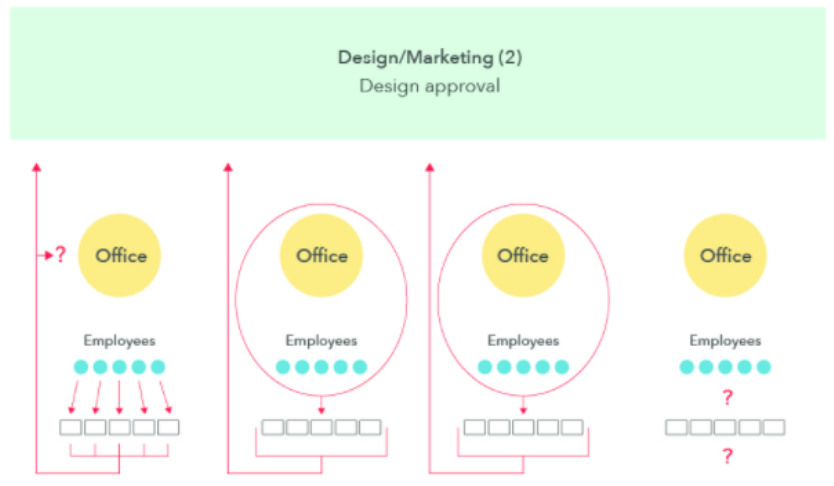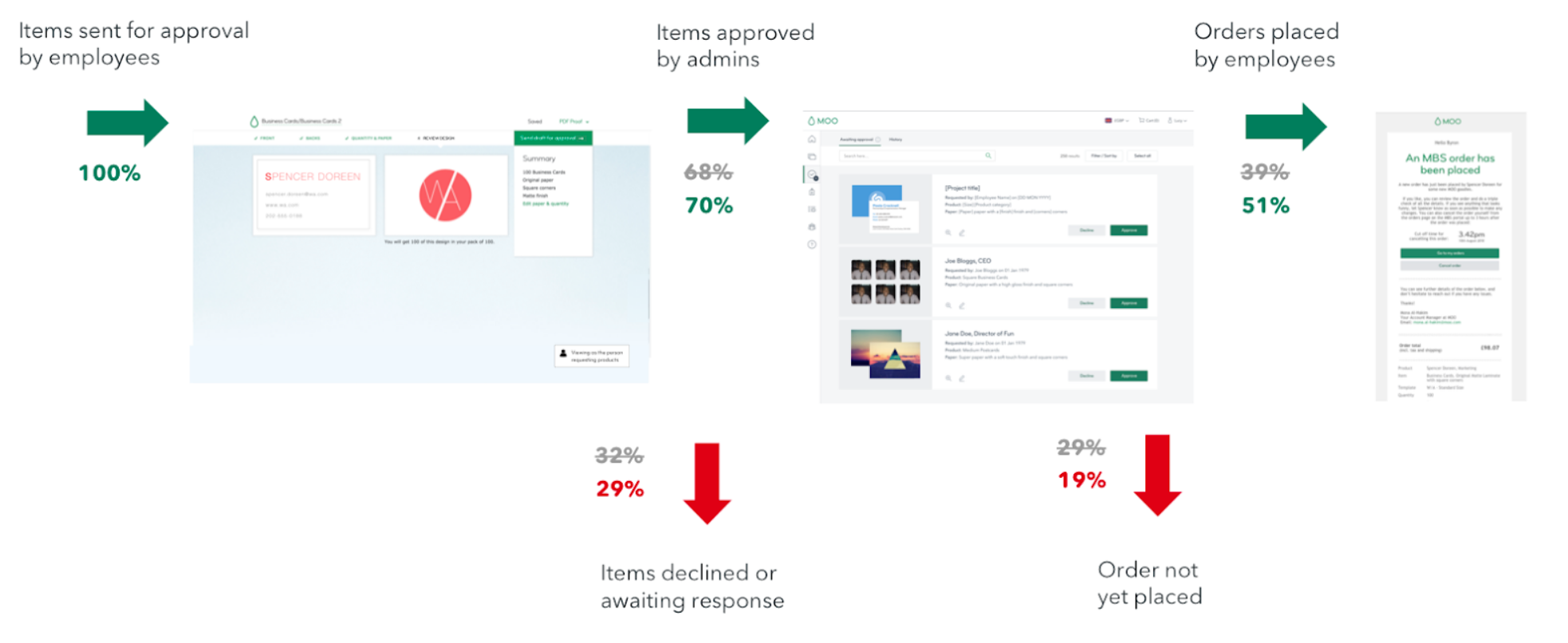Introducing approvals to MOO Business Services
About MOO
MOO is an online print and design company with a mission to make great design available to everyone, and best known for printing premium business cards. MOO Business Services is their fast-growing platform and service offering for larger businesses.
My role
As an Experience Design Lead, a key part of my role involved developing the strategy and managing day-to-day delivery of the customer experience for MOO Business.
MOO works in agile crews & tribes, roughly following the Spotify model. I collaborated with the multidisciplinary MOO Business crew throughout the discovery, design and development processes - in particular coaching and working closely with our Midweight Experience Designer.
A new feature
Approval was a new feature for our MOO Business platform which was demanded by a number of our highest value corporate customers.
The feature would allow employees to submit products they would like to have printed to their internal admins for approval before they could be ordered. One potential customer in particular, MOOs biggest ever, was holding off on signing up with us purely because of needing this functionality.
Discovery phase
The discovery process began with building a thorough understanding of the problem space, whilst engaging stakeholders
We created and used a responsibility assignment matrix (often referred to as a RACI) to make sure that the right people were engaged, consulted and informed throughout the project.
The project kicked off with a stakeholder discovery workshop, a series of activities that I devised and facilitated in order to:
Engage key stakeholders
Build a shared understanding of the problem space
Capture assumptions, hypotheses, ideas and concerns
I promise the workshop was much more fun than this picture makes it look 😂
The insights and hypotheses which emerged from the workshop were supplemented with desk research, a thorough competitive review, and an analysis of previous research/data relating to customer behaviour. I compiled the key findings in a slide deck which set the overall focus and direction of the project, helped to communicate the initiative to the wider stakeholders, and provided the starting point for our formative research.
User interviews
With a clear context and hypotheses in mind, the next step was to explore the customer needs through in-depth qualitative user interviews
With the support of our researchers, I planned and facilitated 10 in-depth interviews with both customers and non-customers.
Key learnings
The research uncovered much more complex and variable sets of needs than anticipated, with variances not just between companies, but for different departments within the same company.
Diagrams to represent the varying structure of approval processes
A dream solution?
Based on the research findings and the output of the stakeholder workshop, it was possible to outline an ideal approach that would satisfy all the varying needs of our customers.
A flow chart of our ideal approach
However, there was no way we could deliver it - due to dependencies across multiple teams, it would take at least 2 years to implement. For example, it required changes to the back-end systems that underpinned our cart - which was handled by a different team in the midst of a large redesign.
Prioritising user needs
The needs we identified were so complex and varied that we realised it would be impossible to satisfy every customer in one go given our limited resources.
To understand the viability of each route required collaborating with multiple crews across the business to understand the impact they would have. To understand how much value each route might add, we needed to get some quantitative data to back up our insights from the qualitative research. I created a customer survey, which allowed us to make an informed decision on which route to begin with.
A page from the results analysis of the survey showing which aspects are most important for customers to approve
Design phase
We began with an MVP based approach, delivering the smallest increments that could provide value, before iteratively designing our chosen approach.
Quick wins
The first couple of iterations were focused on solving small customer problems - quick wins to deliver value to our largest and most valuable customers.
MVP1: A notification reminding employees to seek approval before ordering
MVP2: Based on research insights into how customers were already using the platform, we added the ability for admins to cancel employees’ orders before they were processed, directly from the admin order notification email.
Iterative design
Designing the core approval functionality was an iterative and highly collaborative endeavour
I worked closely alongside our Midweight Experience Designer to iterate on an approvals solution. We started by sketching concepts on paper, and gradually moved to higher levels of fidelity (utilising and evolving elements from the MOO design system) whilst getting regular feedback from users, stakeholders and the technical team along the way.
Snapshots to demonstrate the evolution of designs for showing products awaiting approval to employees
User Testing
We conducted 3 rounds of user-testing:
1st round: To build our overall understanding of potential routes. In-person test with 6 participants and a conceptually focused paper prototype.
2nd round: To evaluate and facilitate a decision between two core approaches we had identified. In-person test with 10 participants and two Marvel prototypes.
3rd round: To improve usability, interactions, and use of language for our chosen design route. Remote test on usertesting.com with 10 participants and a Marvel prototype.
I planned and conducted the majority of the research myself, with guidance from our Head Of Research (who also handled recruitment) and support from our Midweight Experience Designer.
Screenshot from the findings analysis for the 2nd round of testing
Example design challenge
A key design challenge was in deciding between a tiled or a horizontal layout
Our initial designs explored where we might be able to reuse components from elsewhere in the site in order to reduce development time and effort. For example, our main product page already used a tiled layout, and so we explored using a similar layout on our approvals page.
The original tiled design for the approvals page, which we put in front of users in the 2nd round of testing
Hypothesis and learnings
Our hypothesis was that users would find the familiar structure of the page easy to learn and comprehend. However, our testing found that users:
Struggled to differentiate between the product page vs the approvals page when they both used the same layout
Needed more information to make an approval decision than could be easily included on the tiled design
Wanted to approve items one after the other rather than scanning through all the items
Improved design
Based on this insight, we devised a new horizontal format for the approvals page, which:
Was clearly differentiated from the product page
Allowed for easier inclusion of key information
Better suited admins’ workflows by presenting the items to be considered one at a time
An updated horizontal design for the approvals page which tested positively in the 3rd round of testing
Build and beyond
I collaborated closely with the MOO Business crew and wider MOO teams throughout the agile development process, working alongside the Product Manager, refining stories in JIRA, writing acceptance criteria, documenting functionality and ensuring tracking was put in place.
We completed and launched the first iteration of the approvals feature to a limited set of customers in Q3 2018
Measuring success
That’s about the end of this case study, but not of approvals - we’re continuing to iterate based on new customer insights and our learnings from data points we’re tracking.
Drop off rates throughout the approval process in November 2018
Next steps
If you’re interested, I’d love to talk you through a follow up case study which explains how we achieved a 12% improvement in one of our key metrics simply by making a small copy change inspired by our data insights.
Just reach out and let’s go for a tea/coffee/juice :)















